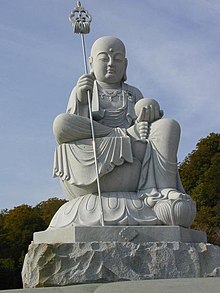Kshitigarbha

Kshitigarbha ( Sanskrit क्षितिगर्भ Ksitigarbha [ kʂɪtɪɡʌrbʱʌ ]; Chinese 地藏 , Pinyin Dizang , W.-G. Ti Tsang ; Japanese 地蔵 Jizō ; Vietnamese Tang Djia ; Tibetan ས་ ཡི་ སྙིང་ པོ sa'i snying po ; Korean 지장 , 지장 보살 , ji jang , ji jang bosal ) is a bodhisattva figure that is particularly popular in Japan .
Japanese Buddhism
The Jizō statues show a Buddhist monk with a shaved head, who is holding a wishing jewel and / or a pilgrim's staff in his hand . Jizō is also often depicted as a child.
Jizō accompanies the souls on their way into the underworld. Legends tell how he descended into hell and saved sinners. Therefore, most of the Jizo statues can also be found in cemeteries.
Jizō is traditionally the patron god of children, especially children who die before their parents. Since the 1980s there has been a trend to worship him as the guardian of the souls of the Mizuko ( 水 子 'water children' ), i.e. stillborn babies , miscarriages and aborted fetuses. This is to be seen in connection with an abortion practice that was widespread at the time because of a ban on contraceptives .
In Japanese mythology , souls of unborn or stillborn children are unable to cross the mythological river Sanzu (三 途 の 川) on their way to the underworld, they remain in a kind of intermediate world. Jizō should now find it and bring it across the river.
The statues often have baby bibs tied around them. These are tied around by parents who hope that Jizō will find their children faster on the basis of this personal possession (the smell).
On the Osorezan (= mountain of terror), an extinct volcano on the edge of a crater lake in the prefecture of Aomori , stands the Entsu-ji temple, founded in 845 , around which a desert of solidified lava spreads. In the middle of this landscape are statues of Jizo. This area is seen as limbo, where Jizo fights against the demons who try to drag the souls of dead children to hell.
Jizō is also often counted among the deities of travelers and ways, the dosojin .
two jizō in Nikkō
literature
- Marinus Willem de Visser: The Bodhisattva Ti-Tsang (Jizo) in China and Japan . Oesterheld, Berlin 1914, archive.org .
- Hank Glassman: The Face of Jizo: Image and Cult in Medieval Japanese Buddhism , Honolulu University of Hawai Press, 2012. online review
Web links
- Jizō Bosatsu . Religion in japan
Individual evidence
- ↑ Ksitigarbha. Retrieved July 10, 2011 .



